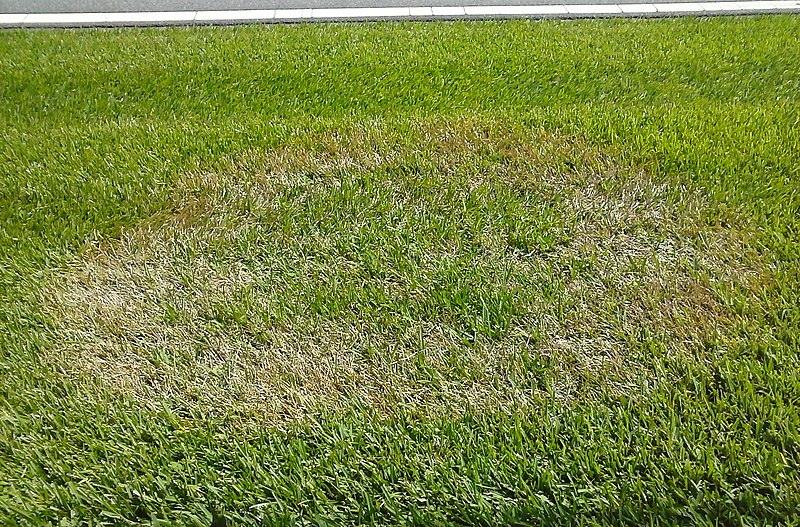Table of Contents Show
Did you know that 20% of the vegetation worldwide is grass? Healthy grass can make all the difference when it comes to how attractive your lawn is. After all, what can complement a house better than yards and yards of even green grass?
But unfortunately, even if you take great care of the grass on your property, you might still find that your lawn is suffering from some ugly brown, withered spots.

These spots and discolorations most likely have something to do with lawn diseases. If you think your lawn has a lawn disease, don’t worry, because it is a common problem that will affect every lawn at some point.
However, if you don’t take the opportunity to treat the fungal diseases in your lawn, the problem might start to spread and your beautiful lawn will be no more.
So, what kind of lawn diseases should you be aware of and what can you do about them? Keep reading and learn more about lawn diseases and lawn care below.
What is a Lawn Disease?
A perfect lawn is actually quite an unnatural phenomenon. In nature, grass, along with every other plant, will be susceptible to insects, fungus, bacteria, and more nasty pests. Once grass contracts one of these conditions, its blades will noticeably change and will no longer appear healthy.
However, the way the grass changes will depend on what kind of disease it might have. For example, diseases caused by stubborn insects might cause different problems compared to lawn diseases caused by fungus. Whatever the case, the result will be more or less the same.
As the disease continues to get worse, the grass will keep getting less and less healthy. The disease may last a while, depending on how severe it is and how healthy the grass was in the first place. But in the end, the grass will eventually end up succumbing to the disease.
Before it does, however, the disease will likely spread to other parts of your lawn. So, you won’t have to deal with one spot of lawn disease but rather a whole chunk.
As time goes on and as the disease continues to spread, your lawn will eventually become less and less attractive and soon there won’t be any healthy grass left to grow.
If your grass completely dies, there will be no hope of reviving it. Instead, you will need to buy new grass in the form of seeds or grass patches. And even once you do that, your new grass will still be vulnerable to various diseases from fungi and insects.
But fortunately, your lawn doesn’t always have to be a lost cause. As long as you act fast and don’t let the lawn disease get too serious, there might be some hope of saving it. But where should you start?
Read Also:
How to Identify Different Lawn Diseases
Before you double down on lawn disease control, you will first need to know more about how to identify different lawn diseases. This is important because not all lawn diseases are the same.
For this reason, some diseases may spread at a different rate, some might kill grass faster than others, and some may be more common than others.
More than that, some diseases only affect certain types of grass. Other lawn diseases might only occur at certain times of the year or in certain regions. You might even need to consider how healthy your grass is.
This is because if your grass is not all that healthy (such as if it was struck by unexpected cold weather or if it isn’t getting enough water), it may be more vulnerable to certain lawn diseases.
After all, if your lawn isn’t packed with essential nutrients, plenty of water, and sunlight, you can’t expect it to be able to fight back against potent lawn diseases.
While this all may sound like a lot to take in, learning the details of how to identify different lawn diseases can be your saving grace when you start to see some mysterious patches on your lawn.
Besides the various factors previously discussed, you will also need to have a good eye when identifying lawn diseases. That’s because some lawn diseases can look very similar to others.
But just because one disease looks like another doesn’t mean that they’re the same. They might be caused by entirely different things.
Knowing this is important because once you crackdown on the disease your lawn has, you will better know how to treat it before it gets too serious. To start, let’s take a look at one of the most common (and most annoying) lawn diseases: brown patches.
The Brown Patch Lawn Disease
When it comes to lawn care, you will find that the brown patch lawn disease is one of the most difficult diseases to keep at bay. Why might this be, you ask? Because the brown patch disease comes about as the result of changes in the weather.
Because you don’t have the power to change the weather in the way you might have to spray away insects or fungus, there is not much you can do when it comes to preventing this disease.
However, that doesn’t mean that your lawn has to sacrifice its beauty if it catches a brown patch. That’s because brown patch, fortunately, is not a very serious lawn condition.
While it might take some time for your lawn to recover, once the weather changes again, your lawn should slowly go back to normal. And, of course, keeping your lawn healthy with plenty of lawn fertilizer and water will help keep the rest of your lawn strong and resilient in the meantime.
Brown patch lawn disease is one of the easiest lawn diseases to identify because it is, indeed, nothing more than a brown patch. You might find only one patch in your yard or you might find several. The patches can start out small but over time, they can easily grow to more than 3 feet in width.
The patch will be circular and the grass within the patch will turn brown or yellow before dying off. This disease occurs when the weather becomes very humid and warm such as during the summer, late spring, or early autumn. If the disease sticks around for a long time, the grass in the center of the patch may start to grow back green again.
However, a ring of dead grass will still remain around the patch’s edge.
The Red Thread Lawn Disease
While waiting will reward you with the brown patch, the same doesn’t apply to red thread lawn disease. That’s because the red thread is a much more persistent disease and, in some cases, it can last for years without going away. Fortunately, the red thread isn’t as ugly as the brown patch, but even so, it can still make your lawn far less attractive.
There is one good thing about red thread, however: it isn’t serious. It won’t end up killing your entire lawn for good. More than that, red thread can actually be a good indicator of your lawn’s health.
That’s because red thread usually only shows up if your grass isn’t getting enough nutrition, especially nitrogen. Nitrogen is important for all plants because it helps the plants photosynthesize (create energy from sunlight) and grow.
So, if you think your lawn might be suffering from red thread lawn disease, don’t hesitate to go to the store and buy some lawn fertilizer that has plenty of nitrogen in it.
After you do this, the red thread should eventually go away on its own. You will be able to identify this disease by the characteristic red threads or webs that appear on patches of grass. The tips of each blade of grass may start to wither slightly, but it would be unusual for the entire blade of grass to die off.
Ryegrass and fescue grasses are more susceptible to this lawn disease than other types of grass, so keep that in mind if you have either type of grass.
More often than not, the red thread will appear in regions where it is humid yet cool. For that reason, red thread tends to be much more common on the Northwestern side of the country.
The Powdery Mildew Lawn Disease
Powdery mildew is a disease caused by fungus. The bad thing about this particular disease is that homeowners often won’t notice that powdery mildew is taking control of their lawn before it’s too late. That’s because the first signs of powdery mildew are very mild and not very noticeable.
For that reason, powdery mildew can actually be sitting around on your lawn for a long time before it starts to cause any real problems. But by that time, the mildew already has a pretty firm grip on your lawn. But the downsides don’t stop there.
Powdery mildew is a particularly contagious disease for plants and it can even affect different species of plants. You should keep this in mind if you have any plants near your lawn that you particularly care about. For example, if you have a garden somewhere near your lawn, you will want to make sure that you keep this lawn disease at bay.
That’s because sooner or later if you don’t treat powdery mildew, it can eventually jump to your garden plants (and sometimes even trees) and cover them in mildew as well.
Once mildew takes hold, it can be difficult to treat because it is a very persistent kind of lawn disease. Fortunately, however, it is not impossible to treat.
You can identify powdery mildew by the powdery nature it gives your lawn. It might even look like your lawn was lightly dusted with baking flour. It usually occurs in places that aren’t great for the growth of grass.
For example, it occurs more often in shady areas with little airflow and too much moisture. The best way to treat this disease is to go out and buy some special powdery mildew treatment from the store.
The Snow Mold Lawn Disease
Snow mold is another pesky fungal disease that can be tricky to deal with. Snow mold, as the name suggests, has to do with the melting of the snow in spring. During winter, your lawn’s grass went into a sort of hibernation and in spring, it has the opportunity to see the sun again and continue to grow.
However, snow mold can quickly put a stop to this if you don’t catch it early. There are actually two types of snow mold: gray snow mold and pink snow mold. Pink snow mold is the more serious of the two because it digs into the crown of every blade of grass.
The crown is the location where the grass meets the grass root. When pink snow mold takes hold of the crown, it can cause serious damage to the grass and it might have difficulty growing again. Gray snow mold, on the other hand, is much less severe.
It involves only the grass’s blade and does not travel near to the root. Grass affected by snow mold will look pale and crusty. You can fix and prevent this problem by making sure that your lawn has good drainage.
It is also important to make sure your lawn gets plenty of sunlight and does not have too much nitrogen. As long as you follow these recommendations, your lawn should be healthy again in no time.
Everything You Need to Know about Lawn Diseases
Lawn diseases can be a pain to deal with, especially if you like to keep your lawn as even and pristine as possible.
Many lawn diseases come about as a reaction to a change in weather or due to an infestation of fungus.
Whatever the case, you should be able to treat most lawn diseases without too much trouble and you should again have a healthy lawn on your hands. To learn more, check out the rest of our website.









